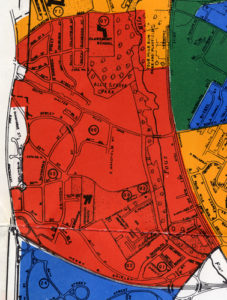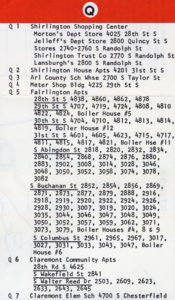
Nuclear attack was a constant boogeyman of the Cold War.
In the 1950s and 1960s especially, American citizenry was encouraged to be proactive in protecting themselves from nuclear fallout (remember “Duck and Cover”?).
Arlington was no exception. In late 1960s, the Northern Virginia Regional Planning Commission, which covered the cities of Alexandria, Fairfax and Falls Church and Arlington, Fairfax, Loudon and Prince William Counties, developed a civil defense plan for a possible nuclear attack. These plans included a fallout shelter program, mapping shelters in regard to population centers and how to get people to those shelters.
The Northern Virginia Region Community Shelter Program, published in 1968, outlined these plans and processes, and also published maps of shelter locations for subsets of the region. The Arlington Edition of the map sectioned the county into color-coded zones so users could find a shelter in their area and contained tips on creating and stocking your own shelter. The above image shows the fallout shelter locations for Shirlington, and the image below lists the names of these shelters. The map itself has the following introduction:
“In case of danger from fallout from a nuclear attack upon this country, you and your family would need to know WHERE TO GO and WHAT TO DO. This Community Shelter Plan contains this information for every citizen. It is based on making the best possible use of the fallout protection now available. If you and your family take action, as this Plan recommends, you will have maximum chance for survival from fallout effects.”

What about you?
Did you have a fallout shelter in your home or neighborhood? Do you remember preparing for “the Big One”? We want to hear from you.
General Olmsted owned a house at the end of Quincy Street. He knew the threat was all too real.
His house reportedly had an amazing shelter that was properly built to weather a blast from the east. The person who developed the site into the five homes said it was very difficult to destroy.
It was required that every house on a corner had to have a fall out shelter. Many churches had them and many of the business districts had them from WW1.
Do these shelters still exist and has anyone opened them up recently? I would love to take a look at one and am curious if anyone still maintains one.
Bobby,
Unfortunately, we don’t know of any bomb shelter on this list that is open to the public – although it is possible that a place like Fairlington could point to a former bomb shelter that has since been converted to a laundry room (or something along those lines).
The Museum of American History collection includes a fallout shelter (exhumed from a yard in Fort Wayne, Indiana) that was on display until 2011. And although it is no longer on display, their website does include photos. and a link to an instruction booklet for building your own bomb shelter.
As an intern at Huntley Meadows Park in Alexandria, VA, I am researching park and local history during the 20th century. I am wondering where you accessed The Northern Virginia Region Community Shelter Program, as I’d love to get my hands on it for my project. Thanks!
My good friend is the second owner of a 1950’s era Arlington home that came with a very-well built sub-basement fallout/bomb shelter. Apparently, the original owner was a government employee (CIA) who took the Cold War very seriously! The shelter is intact, and we visit it occasionally. Our generation was born at the very end of the Boomer Years – ’63/’64 – so we remember those old Civil Defense signs that you still sometimes come across walking in town. Neat history – but even better that we did not use those shelters for their intended purpose!
I live in Utah but once lived in Fairlington. I was recemtly told by Patty Clark of the Fairlington Historical Society about your Back Pages story on fallout shelters. As she pointed out, one of the shelters was in the apartment building at 4813 30th St. So. That is the building, apartment A-1, I lived in with my Mom, Dad and older sister in 1944-45. I turned 5 in August, 1945 and remember the neighborhood celebration the day the war ended (VJ Day). I also remember going more than once with my mom and sister (dad was in the Navy and away) into a bomb shelter during air raid warnings and black-out nights before the war’s end. I don’t remember if it was in the same building but I do remember we didn’t walk (run) far, somewhere close to our apartment. I remember there was a laundry and coal bins in the basement, so the bomb shelter could also have been there. Unfortunately, both my parents and sister are all gone now so I have only my fading memory of those young years to go on. I would guess that that WWII bomb shelter of the 1940s at 4813 30th St S would have also been used as the 1950-60s Cold War fallout shelter. Gratefully, it was never needed for either purpose.